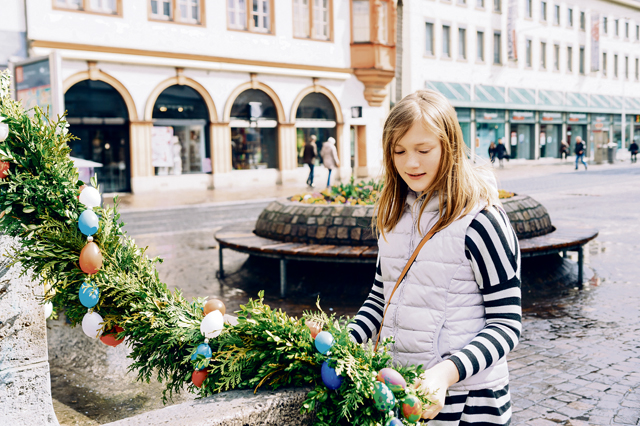
by Nicole Karsch-Meibom
contributing writer
Easter is a happy time. After a long winter, finally nature is in full bloom. Children are waiting for the Easter bunny. Employers usually manage to combine their free days into a long weekend. School is out for at least a couple of days.
In the Christian tradition it’s the finale of Lent season and last but not least, it represents the end of spring cleaning. Needless to say, next to Christmas, Easter is Germany’s most popular holiday.
The multitudes of traditions following this day stem from Christian and heathen times but all evolve around the same idea: the rebirth of nature, the resurrection of Christ and the celebration of life itself. At the same time, copying nature’s spring beauty, people decorate their homes and gardens with adorned, dyed or ornamented eggs whose preparation is a popular family event.
Especially scenic and well worth a trip is a custom of villages in the southeast of Germany. In the Frankonian Swiss, many communities set up Easter wells with hundreds of colored eggs. While the original idea was to honor water for its gift of life, this has become a popular competition between the villages for the well with the highest number of eggs.
The connection of eggs and Easter dates back to the Medieval Ages. During Lent season, the church did not allow the consumption of eggs. As a consequence, great numbers of eggs were amassed in the weeks prior to Easter. During the festive days they were then used as means of payment, or little presents. Later, exchanging these little gifts became a popular custom between sweethearts.
Apart from optical pleasure, Easter also meets the joy of eating, especially for any sweet tastes. Only Christmastime assortments can rival the wide range of sweets offered in the supermarkets during Easter time. From little chocolates to handmade truffles, not just children enjoy the contents of their Easter baskets. But there is even more food to it. “Easter lamb” is one speciality that no longer consists of meat nowadays, but refers to a cake formed like the very animal. Other bakery products look like rabbits, roosters or poults. Another typical seasonal delight is
sweet plaited milk bread nicely braided into an Easter wreath. So, even without religious intentions, it is well wise to meet this season with some prior dieting.
What would this time of year be without the leading character: the Easter bunny, which was first mentioned in the medical scripture “De ovis paschalibus,” about Easter eggs, by physician Georg Franck von Frankenau in 1682.
German children believe that according to their behavior, the Easter bunny brings and hides the eggs throughout the house. So, Easter Sunday usually starts with the children’s treasure hunt. Often enough, by the way, it ends with parents secretly counting the sweets to avoid finding melted chocolate remains later in summer.
Apart from culinary delights, there are a few playful and competitive customs, too. In many rural areas, huge wood stacks are prepared and on the evening of Easter Saturday, the fires are lit to cast out wintertime. Sometimes, this is also represented by straw figures that get burned. Often, the village men contend for the tallest fire. A speciality of the city of Lüdge in Westphalia is the “Easter Wheel,” where a burning oak wheel filled with straw rolls down a hill at night.
“Ostereiertitschen,” the egg tapping game, is a popular competition among young people. Two players take hard-boiled eggs and hit them against another. The egg whose shell remains intact wins. “Ostereierschieben,” egg rolling, has a tradition dating back 400 years to the East German city of Bautzen. On Easter Sunday, children of affluent families used to let eggs roll down the Protschenberg hill to be picked up by poor children. Nowadays, contestants use plastic balls and can win prizes. Finally, an almost mythical custom evolves around the “Easter water,” which dates back to ancient times. Young girls drink water from a spring in silence before the first rays of the sun meets them. The water is attributed healing influences and the gift of fertility.
So, lot’s of things you can do with eggs — rolling, tapping, painting, hiding. But no matter if you celebrate the resurrection of Christ or the rebirth of nature, Easter is a very popular time in Germany.
Whether it is burning wheels or chocolate eggs, sacred water or Easter cakes, it is a time filled with joy and anticipation.


